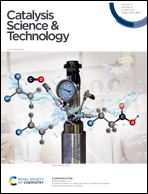Kinetic and spectroscopic insights into the behaviour of Cu active site for NH3-SCR over zeolites with several topologies†
Abstract
Cu–zeolite catalysts are promising for the selective catalytic reduction of nitrogen oxides using ammonia as the reducing agent (NH3-SCR) but rational catalyst design requires a better understanding of the effect of zeolite topology on NH3-SCR activity at low temperatures. Herein, the catalytic activities of Cu–zeolites with different topologies (MOR, MFI, *BEA, and CHA) and various Cu ion-exchange levels for low-temperature NH3-SCR (at 473 K) were investigated. To allow comparisons of catalytic activities among Cu–zeolites with different topologies, the “cation density in micropores” of zeolites was defined, and a similar cation density in micropores was achieved for each topology by varying the Si/Al ratio. The dependence of the turnover frequencies at 473 K on the Cu density in micropores was strongly influenced by the parent zeolite, although the widely accepted reaction mechanism was independent of the zeolite topology. MOR zeolites showed low turnover frequencies irrespective of the Cu density in micropores. In contrast, *BEA zeolites exhibited extremely high turnover frequencies at a low Cu density in micropores, but the turnover frequencies did not increase considerably at higher Cu densities in micropores. Time-resolved UV-vis measurements were used to calculate the rate of the reduction–reoxidation cycle for Cu ions during model transient reactions over different zeolites. It was clearly demonstrated that the turnover frequency for NH3-SCR was dominated by the Cu+ to Cu2+ reoxidation cycle, regardless of the zeolite topology and the Cu density in micropores. The reoxidation of Cu ions on *BEA zeolites was rapid, even at low Cu densities in micropores, and the effect of increasing the mean Cu density in micropores was small. It was also suggested that Cu2+ interacted with zeolite framework oxygen, even under NH3 flow. Thus, it is likely that the local structure and distribution of ion-exchange sites for divalent ions affect the reoxidation cycle during NH3-SCR. It is proposed that development of Cu–zeolite catalysts that have both high reaction rates for NH3-SCR and low Cu volumetric densities can be achieved by considering the zeolite topology.



 Please wait while we load your content...
Please wait while we load your content...